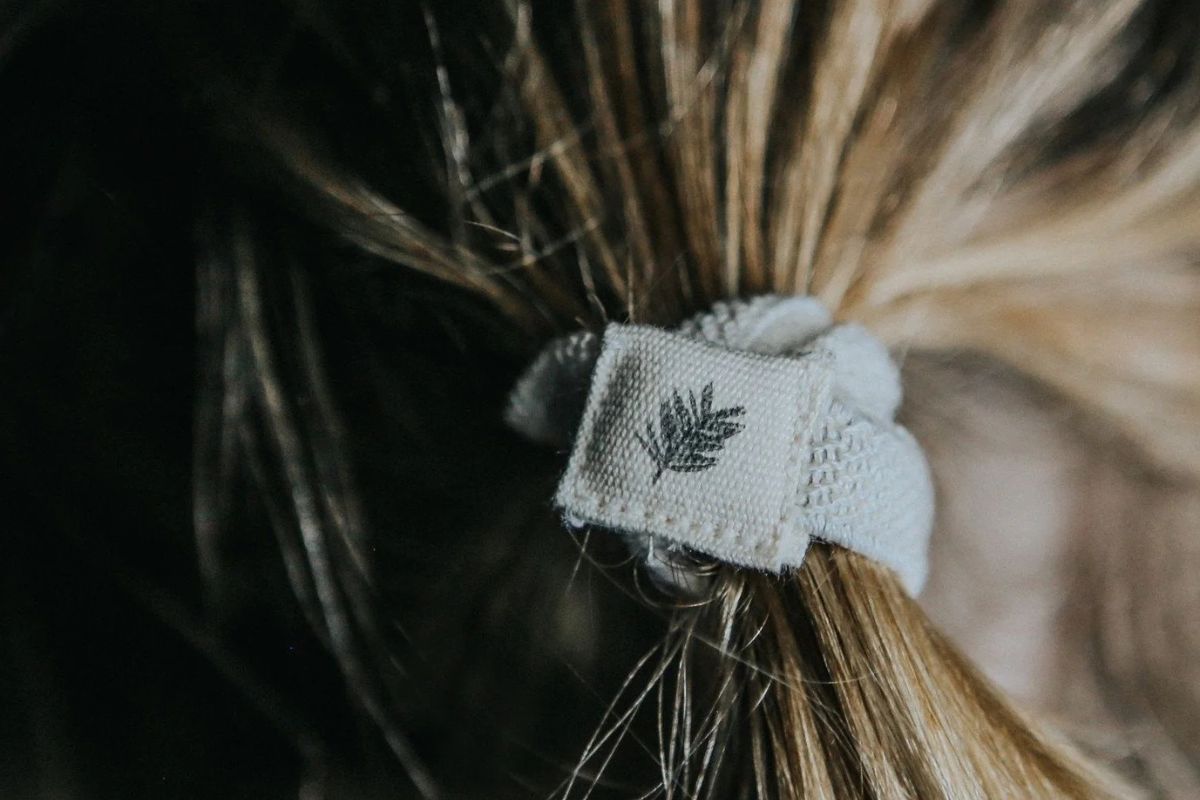Your Cart is Empty
INFO

Are Hair Ties Bad for the Environment?
June 16, 2025 4 min read
We’ve all been there – you’ve lost a hair tie again, and need to replace the pack of 50 you swore would last you. That one lost hair tie might seem minor, but it joins billions of others contributing to a surprisingly large environmental problem.
In this article, we explain more about how hair ties impact the environment, and the kinder alternatives that you can use.
Why Are Hair Ties Bad for the Environment?
That innocent-looking elastic band has a secret: plastic. Most conventional hair ties are crafted from synthetic materials like polyester (derived from petroleum) and nylon, combined with synthetic rubber cores.
Once lost or discarded, these synthetic hair ties can take a staggering 500 years or more to begin breaking down. This is the equivalent of a hair tie discarded during the Victorian era still sitting in a landfill in 2025!
As well as filling landfills, hair ties also contribute towards clogging drains and polluting waterways and oceans. In water, they pose entanglement or ingestion risks to birds, fish, and marine mammals. Alarmingly, the Australian Platypus Conservancy reports that 30% of all litter-related platypus deaths since 2010 have been caused by entanglement in elastic hair-ties.
And there’s a mindset problem to consider. Because they’re cheap and frequently snap or get lost, we treat them as disposable, quick-to-replace items. There’s a reason it doesn’t take long to spot a hair band lost on the street! In fact, 25,000 lbs of plastic hair ties are lost or tossed daily in the USA because of planned obsolescence.
But the result shouldn't be ignored - A constant stream of non-biodegradable hair ties contributes to microplastic pollution and landfill overload.

Are Plastic Hair Ties Bad For Your Hair?
Plastic hair ties are not just bad for the environment; they're bad for your hair, too. Their design can lead to breakage, split ends, frizz, and even hair loss due to the tension and friction they create.
Can Hair Ties Be Recycled?
The short, and disappointing answer is no, hair ties generally can’t be recycled.
Traditional hair ties are typically a complex blend of synthetic fabrics and sometimes metal clasps or glue. Because recycling facilities are designed to handle single material streams, separating the different components in a hair tie is difficult and unfeasible at scale.
There are also currently no widespread, dedicated collection or processing streams for mixed-material small elastic items like hair ties.
Hence, they end up as rubbish and in landfills.
Switching away from conventional hair ties is a small but significant act towards reducing the consumption of non-biodegradable ones. Alternatively, reusing hair ties for as long as possible and finding creative upcycling solutions once they lose their elasticity for hair can help.

Alternatives to Plastic Hair Ties
You don’t have to choose between managing your hair and protecting the planet with our alternatives to hair ties. Here's what to look out for:
1. Organic Cotton & Natural Rubber
While no hair tie lasts forever, well-made organic cotton and natural rubber ties are designed to last much longer than their counterparts. These hold up well to regular use and sports activities without snapping or stretching out. As one of our customers says in their review of our plastic-free hair ties: "They last forever...well, nearly"!
Soft organic cotton is comfortable against your scalp and won’t cause discomfort or headaches like tight elastics can. Plus, these minimise creasing or "dents" in your hair.
Take your hair up and down? These are more comfortable when worn on your wrist. Instead of being too tight, which can compress blood flow to the skin, irritate skin and trap bacteria, the organic cotton is much gentler on your wrist.

2. Biodegradable
Hair ties made purely from organic cotton and natural rubber will completely biodegrade under the right conditions (like in a home compost or landfill) within a reasonable timeframe, typically months or a few years, not centuries.
3. Ethical Production
Many sustainable hair tie brands, like Kooshoo (operating in LA) and Wild & Stone (focusing on fair conditions in Tamil Nadu, India), prioritise ethical manufacturing, fair wages, and safe working conditions.
Treat your hair ties like the valuable (and now eco) items they are. Keep track of them! Store them in a specific spot. Avoid stretching them unnecessarily. Having fewer items in rotation at once can make you less likely to lose them.

How to Reuse Hair Ties
Don’t get rid of your hair tie when it's done! Even conventional ones deserve a second life before landfill. Here are some ideas:
- Cable & Cord Organiser: Bundle computer chargers, headphone wires, or garden hoses. No more tangled mess!
- Jar & Bag Seal: Securely close half-used bags (crisps, flour, frozen peas) or keep lids tight on jars.
- Trouser Waist Extender: Loop through a buttonhole and around the button for temporary breathing room.
- Secure Hung Clothes: Wrap around the ends of wire/slippery hangers to stop clothes sliding off.
- Temporary Luggage Zipper Pull: Loop onto a stubborn zipper for better grip when packing.
- Plant Support Tie: Gently secure stems to garden stakes (softer on plants than wire).
- Fridge Storage: Keep herb stems fresh longer by wrapping a damp paper towel around them and securing with a hair tie. Get more food storage ideas in our post.
And, if you can, pick up, snip and dispose of any hair-ties or ring-shaped litter you find.
How Wild & Stone Can Help
Wild & Stone's mission is to create stylish and easy-to-adapt alternatives to common plastic products around the home, including plastic-free hair ties in black, natural,blonde, and multi-colour variations. Read more about how our hair ties are different below, and order yours on our website.

We source all our products sustainably, from raw material to final delivery. Shop all of our sustainable home & lifestyle products on our website, or browse our household collection for more kitchen and bathroom swaps.
Share your plastic-free swaps with us at hello@wildandstone.com or tag us on Instagram #wildandstone.
Also in Sustainable Living Blog

Everything You Need to Know about Reusable Produce Bags
May 29, 2025 4 min read
In this guide, our experts share everything you need to know about reusable produce bags, including how to use (and re-use) them, their benefits, and how to make them last.

Are Wooden Utensils Better Than Plastic? Your Complete Guide
May 14, 2025 5 min read
When shopping around for utensils, whether it be for cooking, eating orcleaning, you’ll likely come across two different materials… wood and plastic. But which is better? Discover everything you need to know here.

Everything You Need to Know About Swedish Dishcloths
May 06, 2025 5 min read
In this guide, our experts share everything you need to know about Swedish dishcloths, including their benefits, uses, and how they compare to sponges and microfibre cloths.
Make your inbox a little more eco!
Sign up and save 10% on your first order of 2 items or more.
Keep an eye on your inbox for the latest eco trends, articles, deals and product releases.


